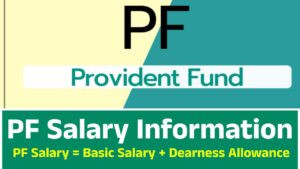PF (Provident Fund) Salary Information
Provident Fund (PF) is a government-mandated retirement savings scheme in India, where both employee and employer contribute a fixed percentage of the employee’s salary each month. The scheme is managed by the Employees’ Provident Fund Organisation (EPFO) under the EPF & MP Act, 1952.

PF Salary Definition
PF Salary = Basic Salary + Dearness Allowance (DA)
It excludes HRA, bonuses, and other allowances. PF contributions are calculated based on this salary, not the gross income.
EPF Contribution Breakdown
- Employee Contribution: 12% of PF salary
- Employer Contribution: 12% split into:
- 3.67% to EPF
- 8.33% to EPS (pension)
UAN System
A Universal Account Number (UAN) links all your PF accounts from different jobs. It helps manage PF online, transfer funds, and track balance easily.
Interest and Tax
- EPF Interest Rate: Around 8.25% annually, compounded yearly.
- Tax Benefit: EPF is under EEE (Exempt at Contribution, Interest, and Withdrawal after 5 years).
Voluntary Provident Fund (VPF)
Employees can contribute more than 12% voluntarily. It earns the same interest but employers are not required to match it.
EPS – Pension Component
The 8.33% from employer’s contribution goes to Employees’ Pension Scheme. Minimum 10 years of service is required to be eligible for a monthly pension post-retirement.
PF Withdrawal Rules
PF can be withdrawn:
- After retirement (age 58+)
- During unemployment (2+ months)
- For marriage, education, home loan, or medical emergencies
- Partial withdrawals are allowed for specific needs
PF Transfer
When you change jobs, your PF can be transferred using the UAN online—no need for physical paperwork if your account is KYC-verified.
Checking PF Balance
You can check your PF balance through:
- EPFO Member Portal
- UMANG App
- Missed Call/SMS Services
- EPFO App
EPFO Online Services
- Download passbook
- File claims online
- Submit e-nomination
- Update KYC details
- Lodge grievances
Benefits of PF
- Government-backed safety
- Long-term savings with compounding
- Tax exemptions
- Emergency fund access
- Pension via EPS
Common Myths Busted
| Myth | Truth |
|---|---|
| Only employer contributes | Both employer and employee contribute |
| You lose PF when switching jobs | You can transfer via UAN |
| You can’t withdraw till retirement | Partial withdrawals are allowed |
Tips to Maximize PF
- Opt for VPF to grow savings faster
- Avoid early withdrawals to keep tax-free status
- Regularly check and update your UAN/KYC
- Keep your nominee details up to date
Who is Eligible?
- Mandatory for employees earning up to ₹15,000/month
- Optional for those above ₹15,000
- Applicable to businesses with 20+ employees
Limitations
- Low flexibility in investment
- No inflation hedge
- Not designed for high-income wealth growth
- Limited withdrawal options
Future of PF
EPFO is evolving with digital tools, UAN enhancements, and plans to extend benefits to gig workers and freelancers.
Conclusion
PF is a powerful tool for financial discipline, retirement planning, and emergency savings for salaried individuals. Understanding how PF salary works, how contributions are calculated, and how to manage your account can help you maximize benefits and build a secure future.
